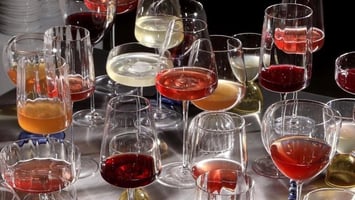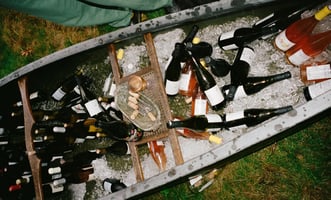Image via Catena Wines Climate change looms over France, Spain, Italy, Greece, and Southern...
Non-Alcoholic Wines are Ripening into a Billion Dollar Market

Non-alcoholic wine is in. As moderation looms over drinkers' minds, it’s no surprise that non-alcoholic beers and wines are taking hold of the market. As these NA bevarages become a mainstream staple, restaurants and wineries are starting to catch up to the “sober-curious” trend grasping consumers.
The Beverage Industry Continues to Grow
Everyone knows wine sales are in decline, but that isn’t totally the case for the flourishing non-alcoholic options. According to an analysis from Fact.MR, NA wine and beer totaled a $2.57 billion market in 2024, growing from $2.26 billion in 2023. The growth isn't faltering either, as the industry is expected to grow to $2.84 billion this year and be worth $7.64 billion by 2035.
Really, the beverage industry as a whole is booming with a saturated market. A report from Statista found that the industry is projected to be worth $276.44 billion in 2025, with an annual growth rate of 8.30% till 2029. Non-alcoholic drinks hold the biggest share of revenue, as companies continue to curate new juices, sodas, canned mocktails, and NA beers and wines.
The market growth is unsurprising, as attitudes towards alcohol have drastically evolved. Americans are heading towards moderation over excessive consumption, and it’s playing a major role in their purchases. This is pivotal for wineries, as crafting NA wine is necessary to spearhead the market. The appeal of 0% alcohol results in a competitive edge and offers their wine as a healthier alternative.
NA products aren’t for those that are totally sober either. With Americans valuing moderate drinking, mixing mocktails and NA drinks between alcoholic beverages is an expanding approach. According to a study by NielsenIQ, 78% of consumers purchasing non-alcoholic beer, wine, or spirits are buying alcoholic versions too.
De-Alcoholizing Wine
For starters, a lot of non-alcoholic wine isn’t actually wine at all, but made of juices and teas to make a “close enough” wine alternative. For a real wine experience without alcohol, you’d be looking for de-alcoholized wine. DA wine is just one version of NA wine, but will get you closest to the taste of traditional wine. Made with grapes, all the normal wine processes occur, including fermentation, but the alcohol is removed before bottling. What’s left is a glass that has the same amount of alcohol as a bottle of kombucha.
Wineries have a few technical options to de-alcoholize their wines: low temperature vacuum distillation or evaporation, reverse osmosis, or spinning-cone columns. Each works a bit differently, but the goal is the same: separate wine into three components (wine, water, and other compounds), remove the alcohol, and combine the remaining parts. Then, like any other wine, it’s bottled and ready for drinking.
The major difference between wines without alcohol and their alcoholized counterparts is they are not for saving. Sadly, it’s not recommended to keep these bottles corked for years on end. Since the removal of alcohol alters the taste, wineries often add juices and additional additives to craft a similar traditional wine flavor. But, without the presence of alcohol, they’re at higher risk of spoiling. Usually they have a two year shelf life, but check for expiration dates.
The Challenges of Non-Alcoholic Wines
Wineries are having a harder time getting in on the NA market than their beer and mocktail counterparts. Alcohol plays a big role in wine, aiding in making a rich, full bodied sip–its removal often results in a lacking profile. But, since the market for non-alcoholic beverages is on the rise and there’s no end in sight, wineries are up for the challenge to produce flavorful NA wines.
The search for making a good de-alcoholized wine has resulted in up-ending the wine-making process as a whole. As many wineries turn towards adding sugar in replacement of the alcohol, it makes any final product overly sweet, losing the rich flavor wine-drinkers are traditionally looking for. But wineries are experimenting in search of alternatives. See The Missing Thorn Wines, crafted by Aaron Pott in Napa Valley, Calif., who uses gum arabic as a replacement, telling The New York Times, it’s a “flavor encapsulator” that gives his de-alcoholized wines more richness and density than other versions on the market.
Some wineries are already crafting versions of exquisite grape juices meddled with flavors to make a similar full-body flavor to traditional wine without the fermentation. Other winemarkers have looked into using only specific wine grapes or adding salt or acidity through limes and lemons to diversify the flavor profile. The overarching goal: just don’t make it too sweet. Wine drinkers, even the non-alcoholic ones, are looking for that perfect robust profile.
So, wine makers: keep experimenting. Restaurants: stock up. We may just find a new flavor profile that fits right in with our budding sober-curious lives.
Follow us on Instagram to explore even more wine!



